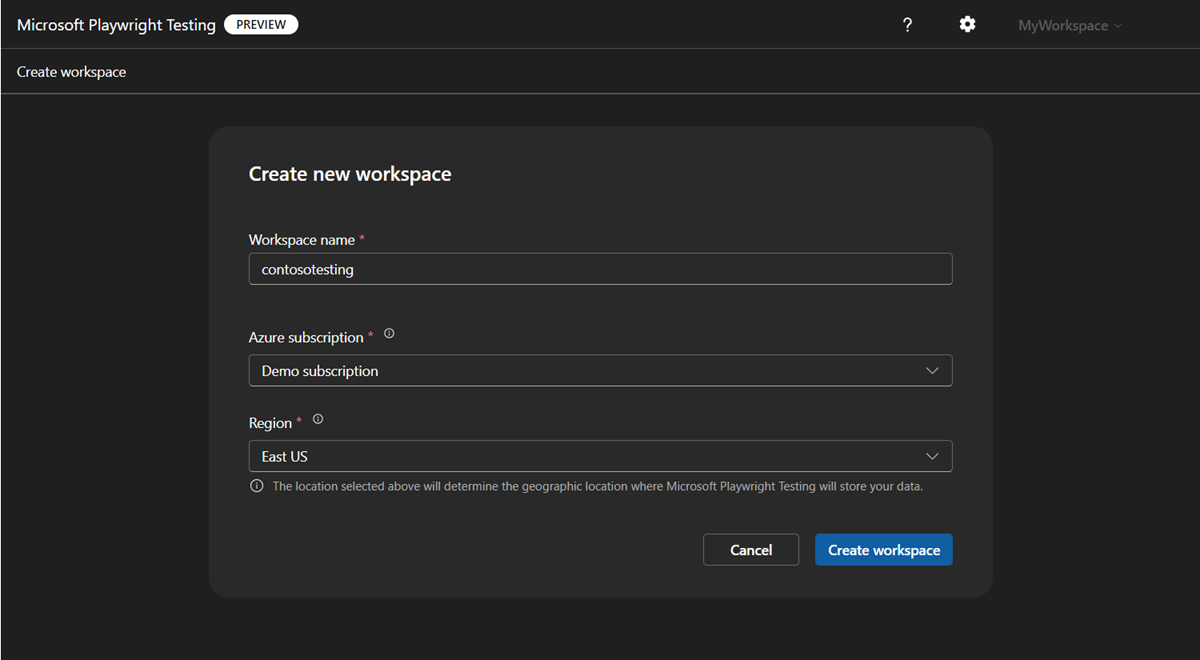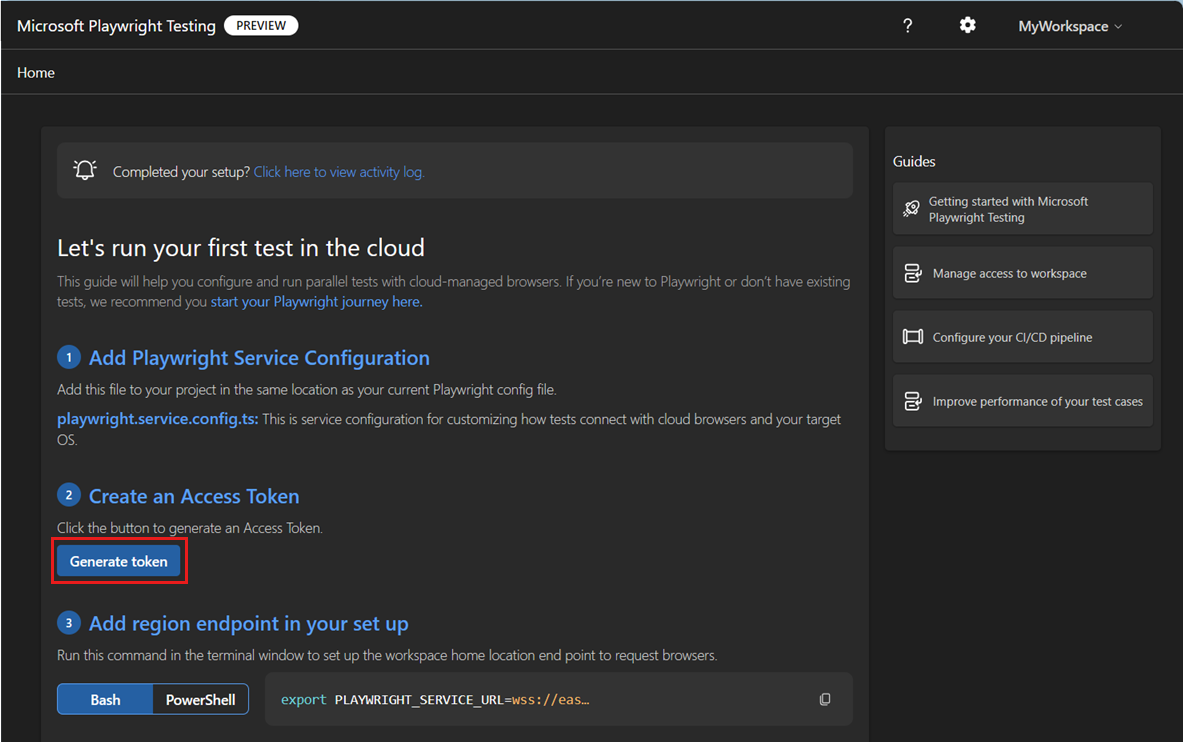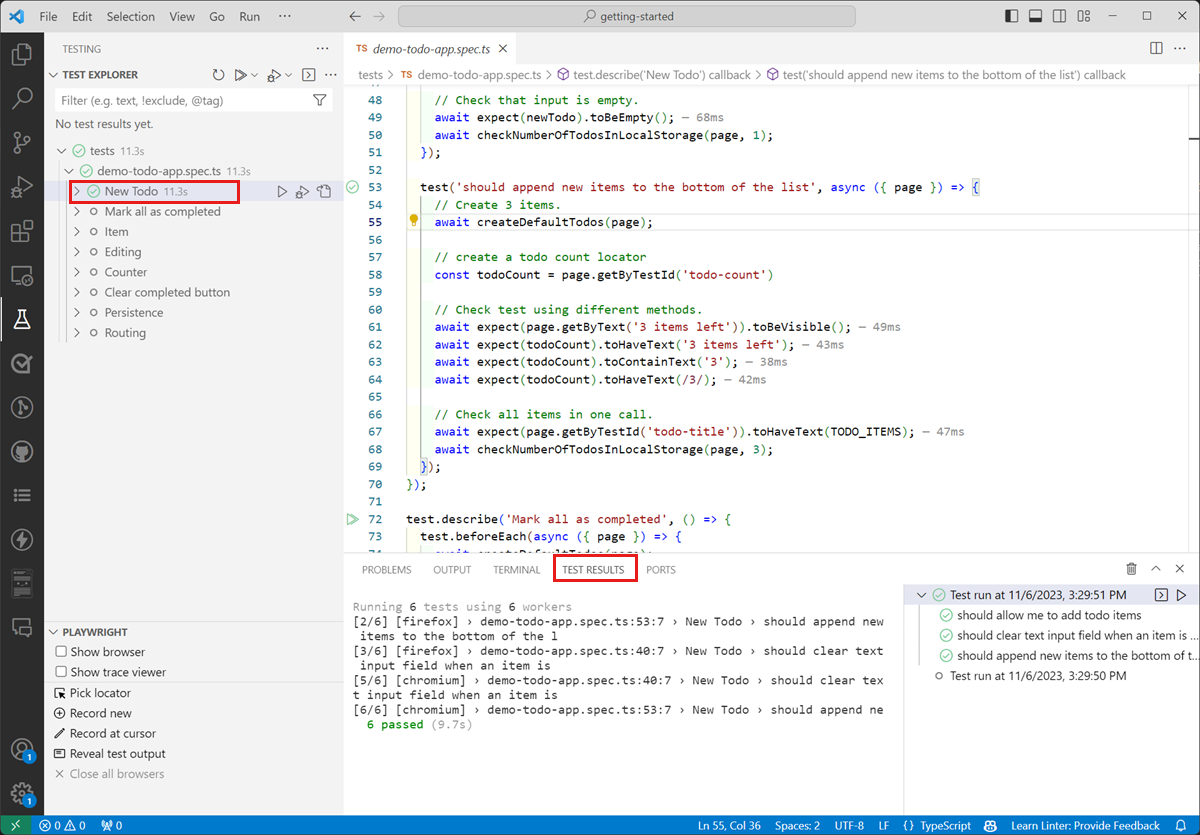Quickstart: Run end-to-end tests at scale with Microsoft Playwright Testing Preview
In this quickstart, you learn how to run your Playwright tests with highly parallel cloud browsers using Microsoft Playwright Testing Preview. Use cloud infrastructure to validate your application across multiple browsers, devices, and operating systems.
After you complete this quickstart, you have a Microsoft Playwright Testing workspace to run your Playwright tests at scale.
Important
Microsoft Playwright Testing is currently in preview. For legal terms that apply to Azure features that are in beta, in preview, or otherwise not yet released into general availability, see the Supplemental Terms of Use for Microsoft Azure Previews.
Prerequisites
- An Azure account with an active subscription. If you don't have an Azure subscription, create a free account before you begin.
- Your Azure account needs the Owner, Contributor, or one of the classic administrator roles.
- A Playwright project. If you don't have project, create one by using the Playwright getting started documentation or use our Microsoft Playwright Testing sample project.
Create a workspace
To get started with running your Playwright tests at scale on cloud browsers, you first create a Microsoft Playwright Testing workspace in the Playwright portal.
Sign in to the Playwright portal with your Azure account.
If you already have a workspace, select an existing workspace, and move to the next step.
Tip
If you have multiple workspaces, you can switch to another workspace by selecting the workspace name at the top of the page, and then select Manage all workspaces.
If you don't have a workspace yet, select + New workspace, and then provide the following information:
Field Description Workspace name Enter a unique name to identify your workspace.
The name can only consist of alphanumerical characters, and have a length between 3 and 64 characters.Azure subscription Select the Azure subscription that you want to use for this Microsoft Playwright Testing workspace. Region Select a geographic location to host your workspace.
This is the location where the test run data is stored for the workspace.Select Create workspace to create the workspace in your subscription.
During the workspace creation, a new resource group and a Microsoft Playwright Testing Azure resource are created in your Azure subscription.
When the workspace creation finishes, you're redirected to the setup guide.
Create an access token for service authentication
Microsoft Playwright Testing uses access tokens to authorize users to run Playwright tests with the service. You first generate a service access token in the Playwright portal, and then store the value in an environment variable.
To generate the access token, perform the following steps:
In the workspace setup guide, in Create an access token, select Generate token.
Copy the access token for the workspace.
You need the access token value for configuring your environment in a later step.
Configure the service region endpoint
In the service configuration, you have to provide the region-specific service endpoint. The endpoint depends on the Azure region you selected when creating the workspace.
To get the service endpoint URL, perform the following steps:
In Add region endpoint in your setup, copy the region endpoint for your workspace.
The endpoint URL matches the Azure region that you selected when creating the workspace.
Set up your environment
To set up your environment, you have to configure the PLAYWRIGHT_SERVICE_ACCESS_TOKEN and PLAYWRIGHT_SERVICE_URL environment variables with the values you obtained in the previous steps.
We recommend that you use the dotenv module to manage your environment. With dotenv, you define your environment variables in the .env file.
Add the
dotenvmodule to your project:npm i --save-dev dotenvCreate a
.envfile alongside theplaywright.config.tsfile in your Playwright project:PLAYWRIGHT_SERVICE_ACCESS_TOKEN={MY-ACCESS-TOKEN} PLAYWRIGHT_SERVICE_URL={MY-REGION-ENDPOINT}Make sure to replace the
{MY-ACCESS-TOKEN}and{MY-REGION-ENDPOINT}text placeholders with the values you copied earlier.
Caution
Make sure that you don't add the .env file to your source code repository to avoid leaking your access token value.
Add a service configuration file
To run your Playwright tests in your Microsoft Playwright Testing workspace, you need to add a service configuration file alongside your Playwright configuration file. The service configuration file references the environment variables to get the workspace endpoint and your access token.
To add the service configuration to your project:
Create a new file
playwright.service.config.tsalongside theplaywright.config.tsfile.Optionally, use the
playwright.service.config.tsfile in the sample repository.Add the following content to it:
/* * This file enables Playwright client to connect to remote browsers. * It should be placed in the same directory as playwright.config.ts. */ import { defineConfig } from '@playwright/test'; import config from './playwright.config'; import dotenv from 'dotenv'; // Define environment on the dev box in .env file: // .env: // PLAYWRIGHT_SERVICE_ACCESS_TOKEN=XXX // PLAYWRIGHT_SERVICE_URL=XXX // Define environment in your GitHub workflow spec. // env: // PLAYWRIGHT_SERVICE_ACCESS_TOKEN: ${{ secrets.PLAYWRIGHT_SERVICE_ACCESS_TOKEN }} // PLAYWRIGHT_SERVICE_URL: ${{ secrets.PLAYWRIGHT_SERVICE_URL }} // PLAYWRIGHT_SERVICE_RUN_ID: ${{ github.run_id }}-${{ github.run_attempt }}-${{ github.sha }} dotenv.config(); // Name the test run if it's not named yet. process.env.PLAYWRIGHT_SERVICE_RUN_ID = process.env.PLAYWRIGHT_SERVICE_RUN_ID || new Date().toISOString(); // Can be 'linux' or 'windows'. const os = process.env.PLAYWRIGHT_SERVICE_OS || 'linux'; export default defineConfig(config, { // Define more generous timeout for the service operation if necessary. // timeout: 60000, // expect: { // timeout: 10000, // }, workers: 20, // Enable screenshot testing and configure directory with expectations. // https://learn.microsoft.com/azure/playwright-testing/how-to-configure-visual-comparisons ignoreSnapshots: false, snapshotPathTemplate: `{testDir}/__screenshots__/{testFilePath}/${os}/{arg}{ext}`, use: { // Specify the service endpoint. connectOptions: { wsEndpoint: `${process.env.PLAYWRIGHT_SERVICE_URL}?cap=${JSON.stringify({ // Can be 'linux' or 'windows'. os, runId: process.env.PLAYWRIGHT_SERVICE_RUN_ID })}`, timeout: 30000, headers: { 'x-mpt-access-key': process.env.PLAYWRIGHT_SERVICE_ACCESS_TOKEN! }, // Allow service to access the localhost. exposeNetwork: '<loopback>' } }, // Tenmp workaround for config merge bug in OSS https://github.com/microsoft/playwright/pull/28224 projects: config.projects? config.projects : [{}] });Save the file.
Run your tests at scale with Microsoft Playwright Testing
You've now prepared the configuration for running your Playwright tests in the cloud with Microsoft Playwright Testing. You can either use the Playwright CLI to run your tests, or use the Playwright Test Visual Studio Code extension.
Run a single test at scale
With Microsoft Playwright Testing, you get charged based on the number of total test minutes. If you're a first-time user or getting started with a free trial, you might start with running a single test at scale instead of your full test suite to avoid exhausting your free test minutes.
After you validate that the test runs successfully, you can gradually increase the test load by running more tests with the service.
Perform the following steps to run a single Playwright test with Microsoft Playwright Testing:
To use the Playwright CLI to run your tests with Microsoft Playwright Testing, pass the service configuration file as a command-line parameter.
Open a terminal window.
Enter the following command to run your Playwright test on remote browsers in your workspace:
Replace the
{name-of-file.spec.ts}text placeholder with the name of your test specification file.npx playwright test {name-of-file.spec.ts} --config=playwright.service.config.tsAfter the test completes, you can view the test status in the terminal.
Running 1 test using 1 worker 1 passed (2.2s) To open last HTML report run: npx playwright show-report
You can now run multiple tests with the service, or run your entire test suite on remote browsers.
Caution
Depending on the size of your test suite, you might incur additional charges for the test minutes beyond your allotted free test minutes.
Run a full test suite at scale
Now that you've validated that you can run a single test with Microsoft Playwright Testing, you can run a full Playwright test suite at scale.
Perform the following steps to run a full Playwright test suite with Microsoft Playwright Testing:
When you run multiple Playwright tests or a full test suite with Microsoft Playwright Testing, you can optionally specify the number of parallel workers as a command-line parameter.
Open a terminal window.
Enter the following command to run your Playwright test suite on remote browsers in your workspace:
npx playwright test --config=playwright.service.config.ts --workers=20Depending on the size of your test suite, this command runs your tests on up to 20 parallel workers.
After the test completes, you can view the test status in the terminal.
Running 6 tests using 6 workers 6 passed (18.2s) To open last HTML report run: npx playwright show-report
View test runs in the Playwright portal
Go to the Playwright portal to view the test run metadata and activity log for your workspace.
The activity log lists for each test run the following details: the total test completion time, the number of parallel workers, and the number of test minutes.
Optimize parallel worker configuration
Once your tests are running smoothly with the service, experiment with varying the number of parallel workers to determine the optimal configuration that minimizes test completion time.
With Microsoft Playwright Testing, you can run with up to 50 parallel workers. Several factors influence the best configuration for your project, such as the CPU, memory, and network resources of your client machine, the target application's load-handling capacity, and the type of actions carried out in your tests.
You can specify the number of parallel workers on the Playwright CLI command-line, or configure the workers property in the Playwright service configuration file.
Learn more about how to determine the optimal configuration for optimizing test suite completion.
Next step
You've successfully created a Microsoft Playwright Testing workspace in the Playwright portal and run your Playwright tests on cloud browsers.
Advance to the next quickstart to set up continuous end-to-end testing by running your Playwright tests in your CI/CD workflow.
Feedback
Coming soon: Throughout 2024 we will be phasing out GitHub Issues as the feedback mechanism for content and replacing it with a new feedback system. For more information see: https://aka.ms/ContentUserFeedback.
Submit and view feedback for










